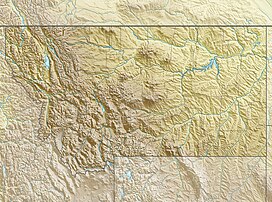Ross Peak
| Ross Peak | |
|---|---|
 East aspect | |
| Highest point | |
| Elevation | 9,008 ft (2,746 m)[1] |
| Prominence | 621 ft (189 m)[1] |
| Parent peak | Sacagawea Peak[2] |
| Isolation | 1.54 mi (2.48 km)[1] |
| Coordinates | 45°51′31″N 110°57′22″W / 45.8585349°N 110.9560432°W[3] |
| Naming | |
| Etymology | Melvin Ross Sr. |
| Geography | |
| Country | United States |
| State | Montana |
| County | Gallatin |
| Protected area | Gallatin National Forest |
| Parent range | Bridger Range Rocky Mountains |
| Topo map | USGS Saddle Peak |
| Geology | |
| Rock age | Mississippian |
| Rock type | Limestone[4] of Madison Group[5] |
Ross Peak is a 9,008-foot-elevation (2,746-meter) mountain summit in Gallatin County, Montana, United States.
Description
[edit]Ross Peak is the fourth-highest peak in the Bridger Range which is a subrange of the Rocky Mountains.[1][6] The peak is situated 13 miles (21 km) north of Bozeman in the Gallatin National Forest. Precipitation runoff from the mountain's east slope drains to Brackett Creek → Shields River → Yellowstone River, whereas the west slope drains to Ross Creek → East Gallatin River → Gallatin River. Topographic relief is significant as the summit rises 3,000 feet (914 meters) above Ross Creek in one mile (1.6 km). This mountain's toponym has been officially adopted by the United States Board on Geographic Names.[3] The mountain is named for Melvin Ross Sr. who settled in the area in 1864 and placed a flag at the summit which could be seen from many miles away.[7]
Climate
[edit]According to the Köppen climate classification system, the mountain is located in an alpine subarctic climate zone with long, cold, snowy winters, and cool to warm summers.[8] Winter temperatures can drop below 0 °F with wind chill factors below −10 °F. Due to its altitude, it receives precipitation all year, as snow in winter and as thunderstorms in summer.
See also
[edit]Gallery
[edit]References
[edit]- ^ a b c d "Ross Peak, Montana". Peakbagger.com. Retrieved July 25, 2024.
- ^ "Ross Peak - 9,004' MT". listsofjohn.com. Retrieved July 25, 2024.
- ^ a b "Ross Peak". Geographic Names Information System. United States Geological Survey, United States Department of the Interior. Retrieved July 25, 2024.
- ^ Final Environmental Impact Statement: Gallatin National Forest, U.S. Department of Agriculture, Forest Service, 1987, p C-94.
- ^ Geological Survey Bulletin 611, USGS, Retrieved 2024-07-25.
- ^ Ken and Vicky Soderberg, Best Tent Camping: Montana: Your Car-Camping Guide to Scenic Beauty, the Sounds of Nature, and an Escape from Civilization, Menasha Ridge Press, 2017, ISBN 9781634040037.
- ^ History of Montana. 1739-1885, Michael A. Leeson, Warner, Beers & Company, 1885, p. 633.
- ^ Peel, M. C.; Finlayson, B. L.; McMahon, T. A. (2007). "Updated world map of the Köppen−Geiger climate classification". Hydrol. Earth Syst. Sci. 11. ISSN 1027-5606.
External links
[edit]- Ross Peak: Weather
- National Geodetic Survey Data Sheet
- Ross Peak rock climbing: Mountainproject.com







